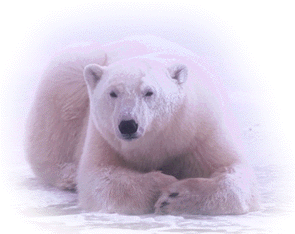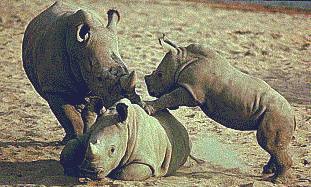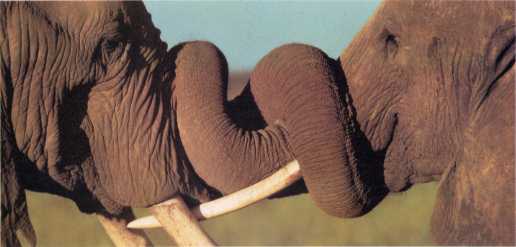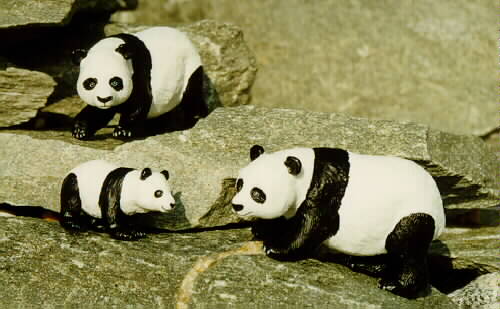
Pandas, Aliuropoda melancoleuca, are classed as bears by most scientists. They have been recently grouped with raccoons. The basic fur color of the panda is white with black eye patches, ears, legs, feet, chest, and shoulders. Within its natural environment its coloring provides camouflage. There is also some people that believe that its color pattern may be a clear message to other pandas to stay away as the panda is an extremely solitary animal. They are one of four bear species that do not hibernate. With few natural enemies other than man, the lifespan of giant pandas in the wild is thought to be twenty-five years or more.
Pandas are difficutlt to keep in captivity because of their strict dietary requirements. Although they have a digestive system suited for a meat eating animal, they shifted their diet to vegetation. Today the live almost entirely on the leaves and stems of bamboo. Because bamboo is relatively low in nutrients, pandas need to eat up to 35 pounds of bamboo a day.
They live in cool, damp bamboo forests at altitudes of 2,600-3,500m (8,500ft) in China 11,500ft). The Panda lives in six small areas located in China. In most of the areas in which
they still roam wild, they must compete with farmers who farm the river valleys and the lower slopes of the mountains.
Bengal Tiger

The white tigers are not albino tigers. White tigers are not a separate subspecies of tiger, they are just white colored Bengal Tigers. They are only born when two tigers both carry the genetic white gene. They have large blue eyes with excellent vision. Their hearing is good with well developed ear flaps. They have large canine teeth and strong, powerful jaws. Their paws are heavily padded with claws that retract. They are found throughout India from the Himalayas to Cape Comorin, except in the deserts. The white tiger is not from Siberia. There are about to white tigers in captivity, not enough to sustain favorable breeding. The six original white tigers have produced the total current population in captivity - 50. Total white tigers in the wild are only about 150 - 200. They are carnivorous. Diet varies according to locality, they prefer deer, wild pigs, young buffalo, young elephants and cattle in general, any prey over 100 pounds in weight. However, when they are really hungry they will eat almost anything: fowl, fish, lizards, frogs, crocodiles, carrion, or even humans. The male regularly patrols his territory, scent and scraping tree trunks.
Ocelot
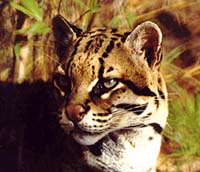
The Ocelot is found in Southwestern US (Arizona and Texas), throughout mexico and Central America, and in South america from northern Argentina and Paraguay to Ecuador, however they are not in chile. They are found in a wide range of habitats, from thorn forests to tropical moist forests. Their diet consists of almost any animal that they can overtake - birds, monkeys, reptiles, frogs, rodents. They feed on the most abundant prey available, usually rodents. However, they may prey on domestic animals if available. Their zoo diet consists of chicken necks and prepared carnivore diet. They mark their territory and defends it against its own kind. They are more faithful to mates than related species. Reproductive years for females in captivity range from 2 1/2 years to 12 years. Ocelots like to keep in dense cover when possible, swims well and climbs trees for prey if needed. Their spotted coat make them inconspicuous, they have very large eyes which allows them to see well in dim light. Because of the demand for fun these animals are endangered. The U.S. has forbidden importation of ocelots or their pelts, except under permit, since 1972.
Bison
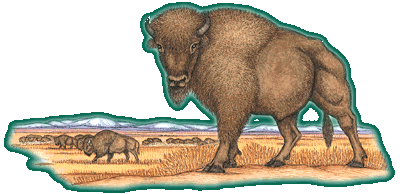
The american buffalo is threatened by its low genetic diversity and its massive populations from the early 19th century. As of right now the buffalo is endangered. The buffalo weighs in at an average of 700-2200 pounds and is any where from 84-144 inches in length. The buffalos habitat consists of plains and grasslands but the buffalo were formerly found in forested areas. The buffalos current range is the Yellowstone Park and the Wood Buffalo Park in Canada. In early efforts to save the buffalo they were hybridized by breeding the wood bison and the plains bison. Bison and pronghorns were very common sights at one time in North America but in the 1800's were almost killed off from a population of over 60 million and by the 1880's they were gone, they had been slaughtered for their hides, sport, and as part of the military's efforts to suppress the indians. By 1895 there were only about eight hundred buffalo left.
Pronghorn
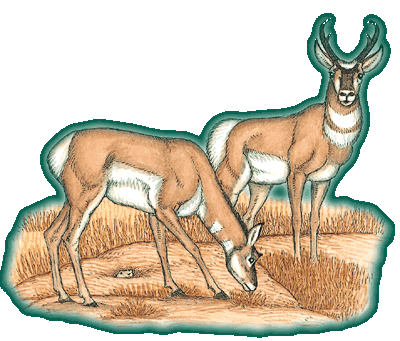
The American Pronghorn has been threatened by illegal hunting the destruction of its habitat and livestock fences which hender the pronghorn from accessing its natural ranges. And as of now the pronghorn is endangered. The pronghorn may weigh any where from 75-140 pounds and may be in length from 40 - 60 inches. The pronghorns habitat consists of semi-dry desert and grass and shrublands where they feed. The pronghorn despite their speed and agility cannot jump and do not jump because it is believed that since the pronghorn evolved on open prairies so the pronghorn would just run around obstacles instead of leaping over them. Today hunting of pronghorns is permitted but limited and only about 40,000 are harvested annually. But the subspecies in Mexico the Sonoran and the Baja are still greatly threatened by illegal hunters. The last surviving pronghorns evelved in North America over a million years ago and still exist as a saga or an old book and once they are gone part of our heritage will be lost forever. Although these animals are well adapted to their habitat there is no real place for them to hide so they rely on good eyesight and the ability to run at speeds of over 60 miles per hour. These animals survive in what some call waste lands and eat thissels, cacti, and sagebrush, and they can even live off of just the moisture they get from what they eat. Also pronghohn are not like deer in that both males and females have antlers permanently affixed to their heads. Lastly the pronghorn has been to the brink of extinction and has come back in that over 200 years ago they ranged from Canada to Mexico and from Washington State to Minnesota with over 40 million in population. But as agriculture spread throughout the midwest it restricted their range and open hunting took its toll. Therefore by the 1920's the population had been reduced more than a thousnd fold. But the pronghorn was saved from extinction through management efforts by conservation groups and hunters organizations. And today there are about 750,000 to one million pronghorn that live in North America.
